“End of an Era”: A Retrospective of Claremont’s X-Men, Part 6
With the end of the Dark Phoenix Saga, Chris Claremont and John Byrne had hit their greatest creative achievement. It would eventually go on to be the most celebrated and one of the most influential X-Men stories in the history of the canon. Because of the changes to the ending at the direction of former Marvel Editor-In-Chief Jim Shooter, Jean Grey sacrificed her life to save the universe, a move that sent seismic shockwaves through the comics industry.
However, in the wake of this tremendous success, one nagging question remained for Chris Claremont, John Byrne, and incoming editor Louise Simonson. How does one follow up on arguably the greatest X-Men story ever told?
Additionally, there were more immediate problems. While Claremont had clear long-term plans he wanted to develop for Uncanny X-Men #150, the change in plans had forced him to quickly revise his short-term plans. Originally, the idea was for Scott and a depowered Jean Grey to leave the X-Men and pursue their lives together, away from the team. Eventually, they would return in time for the Magneto arc in #150, where Scott and Jean would play a role. However, with Jean now dead on the moon, plans for the next issue were now in flux, and Claremont and Byrne needed to restructure quickly.
The result is “Elegy”“, which focuses on Scott as he witnesses the funeral of Jean Grey. On the surface, this story is merely a recap of previous X-Men stories, stretching from the first issue to Jean“s death. This is perhaps a wise decision, as it gives a good starting point for new readers who might have jumped on with that issue. However, it was probably also a way for Claremont to avoid his usual complex plotlines for an issue, allowing him to rework his plans for the next twelve issues.
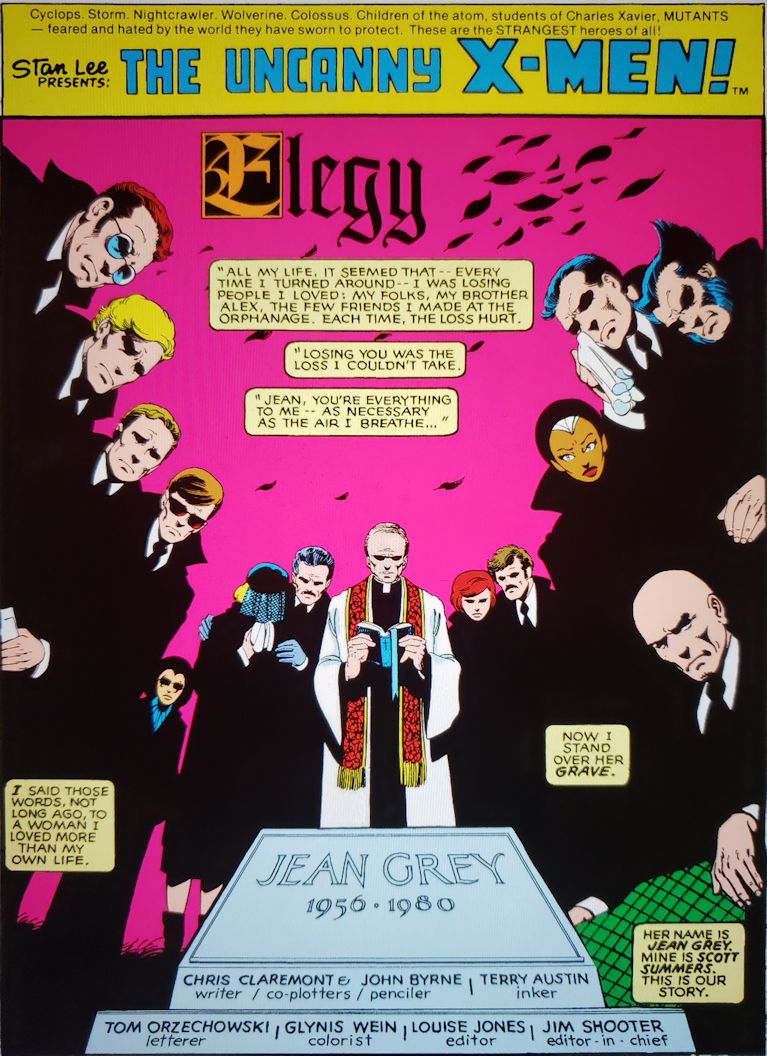
Moreover, “Elegy”“ is a deeper story than the recap it appears to be. While the basic plots of Silver Age and Claremont-era storylines are retold in this issue, they are observed from the point of view of Scott Summers. In this way, “Elegy”“ functions as a character study of Scott as he reacts to these events, showing his emotional arc during the time he spent with Jean. It“s a story about Scott“s love for Jean, about how her love reached through to him, and how it cracked the emotional armor of a tightly wound and controlled young man. Claremont offers insights into various moments of Silver Age X-Men history at times, such as how much pressure Scott was under during his time filling in for Xavier as headmaster, and how that affected his relationships. It“s a “new reader friendly”“ issue that neatly explains Scott“s character, and it succeeds as a breather issue.
Though “Elegy”“ is a story about endings, it also focuses on new beginnings, as it sets up the new status quo of the X-Men. The most significant changes are in the X-Men“s roster, which evolves slightly over the next few issues. Kitty Pryde, who debuted with the Dark Phoenix Saga, officially joins the X-Men with this issue. Scott leaves the team, and he does eventually return with the Magneto arc in Uncanny X-Men #150 as Claremont planned, though he gets there through a more roundabout path. In the meantime, Angel takes Scott“s spot on the team, most likely because John Byrne enjoyed drawing him than because Claremont had any firm plans or interest for Angel at that time. With Scott gone, Storm becomes the new leader of the X-Men, creating a new dynamic that sets the tone for the book for years to come.
The one last notable point about “Elegy”“ is a parting gift from Lilandra to Jean Grey“s grieving parents. Lilandra gives them a holempathic matrix crystal, which generates an image of Jean, but also stores an imprint of Jean“s personality. It“s not explained or shown how Lilandra would have been able to create such a thing, even with advanced Shi“Ar alien technology, but it becomes an important plot item in many later Claremont Phoenix stories. It especially becomes a key item for Rachel Summers, who would make her debut a few issues later. It“s quite possible that Claremont planted the matrix crystal with only a vague idea behind it; he was well known for establishing dangling plotlines without necessarily knowing what these ideas might lead to until he returned to them. However, the crystal plays a huge role in the story of the Phoenix, since this item carries a large importance in Claremont“s larger Phoenix mythos.
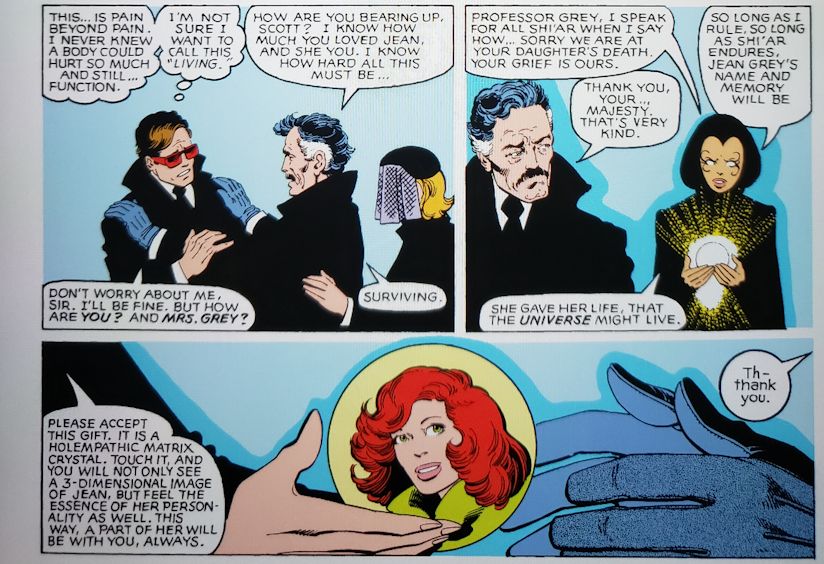
Far less important to the X-Men“s mythos is that year“s annual, appropriately called “Nightcrawler“s Inferno”“. Though there are some good ideas in this story, the issue itself is a small misfire, and even solid early art by John Romita Jr. doesn“t elevate it that much. In fairness, the basic setup is good; Nightcrawler“s foster mother Margali Szardos comes to get revenge on Kurt, and this prompts the X-Men to team up with Doctor Strange to resolve the dispute. This synopsis sounds better than the issue actually is, since much of the issue deals with the X-Men fighting opponents in a setting inspired by Dante“s Inferno. The process of getting through these fight scenes is unfortunately tedious, skipping past the real meat at the heart of the conflict. Once the story gets there, the good points dealing with Kurt“s past are woefully rushed, shown though recap panels that offer little real emotional weight. Because of this, Kurt“s reconciliation with Margali lacks weight as well, despite Claremont“s best efforts to make the ending work.
The one lasting element of this annual is the revelation that Kurt“s girlfriend, Amanda Sefton, is not the woman she“s presented herself as. Amanda is unveiled as Jimaine Szardos, daughter of Margali and Kurt“s foster sister, and a sorceress herself. Once Kurt realizes that Amanda is Jimaine, there“s a happy ending, and nothing is made of the consequences of their relationship changing. When I read Kurt and Amanda“s relationship the first time, I was too young to notice the creepy implications of this, and I accepted the surface-level reading. In hindsight, I cannot imagine why Claremont made this decision, especially with a deeply moral and faith-driven character like Kurt. Claremont pushed some edgy ideas past the radar many times during his run, and this would not be the last occasion he did so. Still, Amanda“s magical background made her a more interesting character, and this background element came into play several times during Claremont“s time with the X-Men.
Speaking of backstory, the next arc is a two-part storyline that deals with Wolverine“s past with Alpha Flight. When last we saw Alpha Flight, the X-Men had fought them in Calgary and managed to escape. At this time, Alpha was following the orders of the Canadian government to bring back Wolverine, who was previously a Canadian secret agent. Wolverine chose to leave Canada to join the X-Men, causing friction between the two groups. At this point, they had two encounters under Claremont and Byrne””once against Vindicator at the X-Mansion, and the battle against the full Alpha team in Calgary.
From this point onwards, Alpha Flight gradually become allies of the X-Men, and they no longer act as the reluctant antagonists that they were in the previous stories. Partly this is because Logan decides to take the initiative to settle his dispute with James Hudson, going up into Canada without most of the X-Men. The only exception to this is Nightcrawler, who comes with Logan to keep him out of trouble. This arc is very much about resolving the Alpha Flight storyline, largely to give the arc a resolution. However, this also allows Byrne to leave Alpha with a clean slate during his final issues, taking the opportunity to show the Alphans as heroes for the first time. The result is a storyline that“s partly a buddy comic with Kurt and Logan, and partly a Canadian adventure with Logan and Alpha Flight.
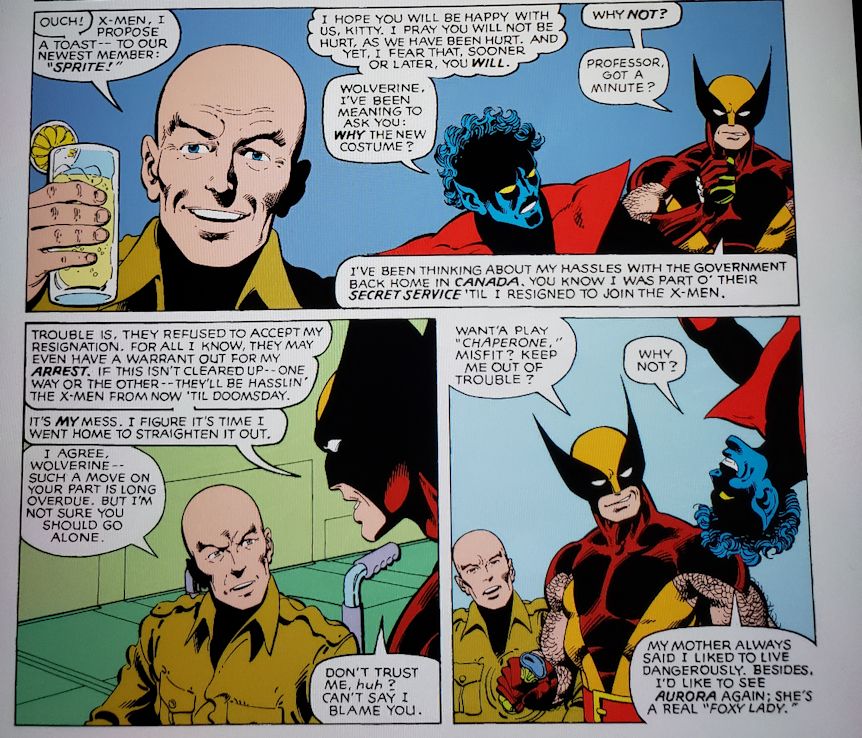
This issue also debuts Wolverine“s brown and tan costume, a design that would remain a fixture until the end of Claremont“s run. Up until this point, Logan was still wearing the yellow and blue costume that he debuted with, though with small adjustments, such as the mask. The yellow costume is arguably more iconic because of X-Men: The Animated Series and the fact that it made a resurgence during Jim Lee“s time on the book. That said, the brown costume always made more sense as a functional costume, especially once the ninja elements of Wolverine“s past were introduced. Brown is a color that works better for a stealth-based character like Logan. It also is a color that reflects Logan“s animal side and his connection with nature, so it works well for him thematically. This is one of John Byrne“s most memorable costume designs, and it is a look that“s still very strongly associated with Wolverine to this day.
In the meantime, Kitty Pryde spends time trying to connect with the X-Men, and getting used to being literally the new kid on the team. Though we see glimpses of her dynamics with them””she“s initially creeped out by Nightcrawler and attracted to Colossus””Kitty bonds most strongly with Storm in these issues. Ororo eventually becomes Kitty“s mother figure in many ways, and she“s the one authority figure that Kitty most listens to. It“s a logical dynamic for Claremont to explore, and it“s a friendship that works for both of them. Kitty benefits from the wisdom and hard experience of Ororo, while Ororo learns to relax around the far less guarded Kitty. In her early years, Kitty is highly intelligent, but without wisdom or experience. She has many childish impulses, and that“s normal for a thirteen-year-old. Ororo helps to restrain Kitty“s more youthful impulses, while Kitty“s idealism and emotional honesty challenge Ororo“s tightly controlled “goddess”“ persona. Their relationship evolves significantly over the years, especially during Ororo“s “Mohawk”“ phase a few years after this.
Claremont also introduces a complication in the growing mother-daughter relationship between Ororo and Kitty. Ororo takes Kitty to dance class in the town of Salem Center, which is run by a retired dancer named Stevie Hunter. Though Hunter is a character who has unfortunately become forgotten in recent years, she was a good character who kept the X-Men grounded in the world of humanity. Claremont gradually built a supporting cast of humans outside of the X-Men, often involving them in relatively minor roles during his run. Stevie Hunter was one of the best of these, offering the human perspective to the X-Men while having a foot in their world. Also, as a dancer, Stevie was able to empathize with those with extraordinary gifts, though with a vulnerability that kept her human. She also added some extra diversity to Claremont“s cast, a point that Claremont may have recognized was lacking in his team at that time. Stevie Hunter was usually connected through Kitty and Ororo, but she also appeared regularly in New Mutants, where she would play a similar role.
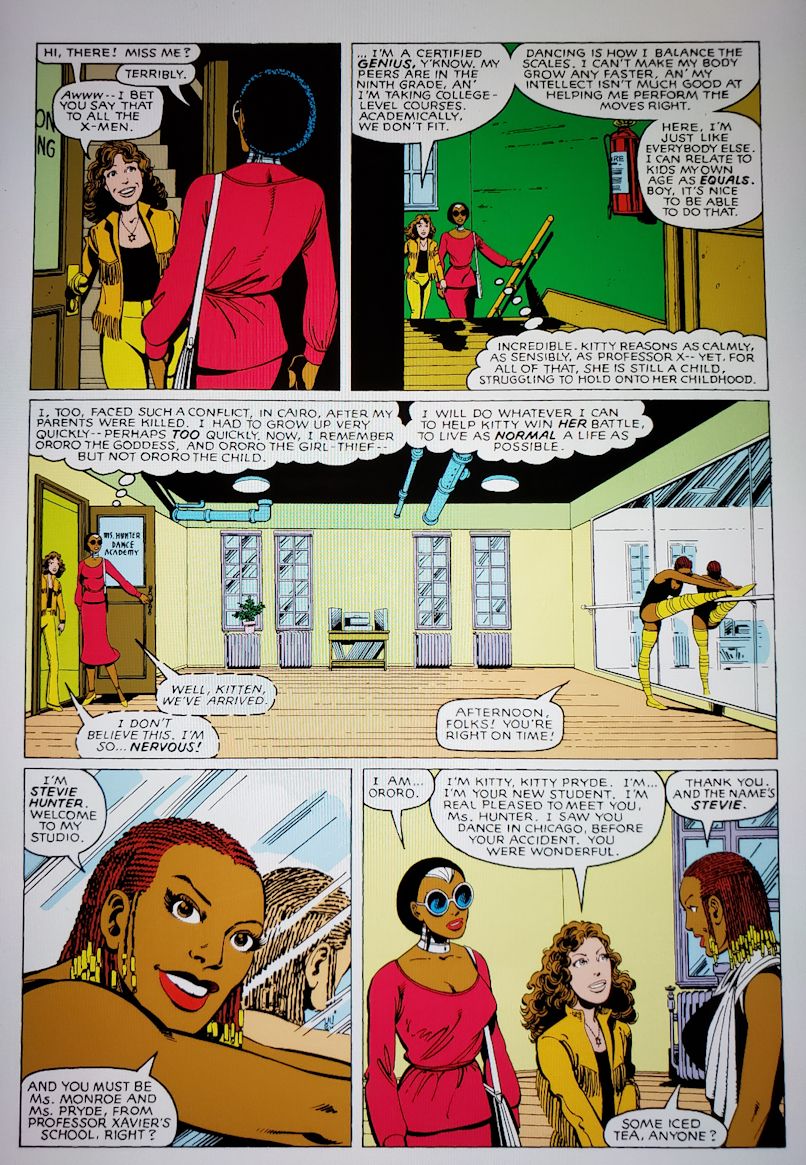
In the short term, though, Stevie Hunter unintentionally sparks some conflict with Ororo as she connects with Kitty in these two issues. Claremont initially sets Stevie as a secondary mother figure to Kitty, something that Ororo finds threatening. Stevie is a likeable character on her own, and it“s interesting to see Ororo struggle with a rival. It“s a situation that Ororo can“t resolve in the traditional way, either using her powers or by using her regal goddess attitude to intimidate Stevie. Ororo has to deal with the problem by opening herself up to Kitty, making herself vulnerable, and that“s something Ororo has difficulty doing. Ororo is a highly guarded woman because that is her way of keeping her powers under control. Being human, allowing herself to relax or be vulnerable, is the one thing that threatens Ororo“s serenity and sense of control, and it causes her to act out of fear and insecurity. Ororo deals with the problem by pretending to ignore it, making her frustration towards Stevie look like concern for Logan and Kurt, but it“s clear to the reader that Stevie unsettles her. It“s an interesting conflict that contrasts nicely with the action-oriented plot involving Logan, Alpha Flight, and the Wendigo.
When the focus returns to Kurt and Logan, we find that they“ve paid a visit to Heather. This is a short scene, but one that lays the groundwork of the situation in Canada. Vindicator is not at home, instead on a trip in the Hudson Bay wilderness with Alpha Flight. More accurately, James Hudson only has half of Alpha Flight with him because Northstar, Aurora, and Sasquatch are on assignment elsewhere. It“s also here that Wolverine is called “Logan”“ for the first time; Heather Hudson is the first person who uses that name, a sign of her earlier friendship with him. Logan has never used that name around the X-Men up until now, a fact that Kurt calls him out on. Logan assures Heather that he“s come to make peace with Vindicator, and the two X-Men leave to find Alpha Flight.
The remainder of the issue is the setup for the main event. We get a scene establishing Alpha Flight“s mission in Hudson Bay and their objective””they“ve come to stop the Wendigo and find a missing family that the creature has taken. At this point, Alpha Flight is undermanned, with three of their most powerful members elsewhere, and they don“t have the raw power to confront the beast. The Wendigo is a monster that fights in the same weight class as the Hulk, a monster created by a magic curse born of cannibalism. The arrival of Wolverine and Nightcrawler is convenient timing for Alpha Flight, who could use the extra manpower, and the X-Men have a good opportunity to make peace with the Alphans. The issue ends with Nightcrawler running into the Wendigo while trying to get supplies from their vehicle, setting up a beautiful dramatic establishing shot by Byrne.
The following issue spends some time with Angel and Colossus, starting off with a strong dynamic shot of Colossus as he uproots a tree. It“s a short character scene, one that shows some depths to Peter Rasputin as it contrasts his poetic soul with his farmer background. However, it“s a scene that mainly focuses on the real conflict, as Wolverine is a sore spot for Angel. When Warren visits Xavier about this subject, Xavier lays down what is probably Claremont“s own view about it, the idea that the team accepts Wolverine because of his potential for good, not because of the violence in his past. This is very much Claremont“s mission statement with Wolverine for years after this, as Logan gradually confronts his darker side and embraces his humanity. However, Angel is briefly a solid counterpoint to that view, and he works as a moral influence on the X-Men in the short time Angel remains with the team.
The Alpha Flight arc concludes with a dramatic action issue, though it hits a core character beat that follows Wolverine as a character. Wendigo works as a Wolverine opponent because he represents what Logan fears most””a man fully divested of his humanity, driven solely by his animal urges. Because Wendigo is so powerful, Logan must push himself to his physical and moral limits to defeat the monster. That is certainly true of this issue, where Logan reaches his berserker fury, turning it against the Wendigo. However, Logan“s high point this issue comes when the shapeshifter Snowbird transforms into a wolf and charges the Wendigo. However, Snowbird is consumed by her own animal instincts, making it hard for her to resume her human shape. Logan uses his instincts and experience with his own animal side to reach Snowbird, restoring her human mind to control and allowing her to resume her human shape. Even against an old foe and pushed to the edge by a nearly unstoppable foe, Logan still overcomes his animal ferocity and even saves Snowbird from losing her own humanity. In the end, the Wendigo is defeated, allowing Shaman to lift the curse.
The resolution of the story is a positive one for the X-Men and Alpha Flight. The Wendigo is defeated and the curse is lifted, and the family the Wendigo threatened is mostly saved. Alpha Flight agrees to put in a good word about Logan“s resignation with the Canadian government, and there are no more attempts to capture Wolverine after this incident. Following this, there is an interesting scene between Logan and Kurt on the philosophy of killing, one that defines the character of Wolverine. Kurt is concerned about the moral implications of killing, which Wolverine initially defends as wartime and espionage acts. Logan then offers a more philosophical answer about how and why he kills:
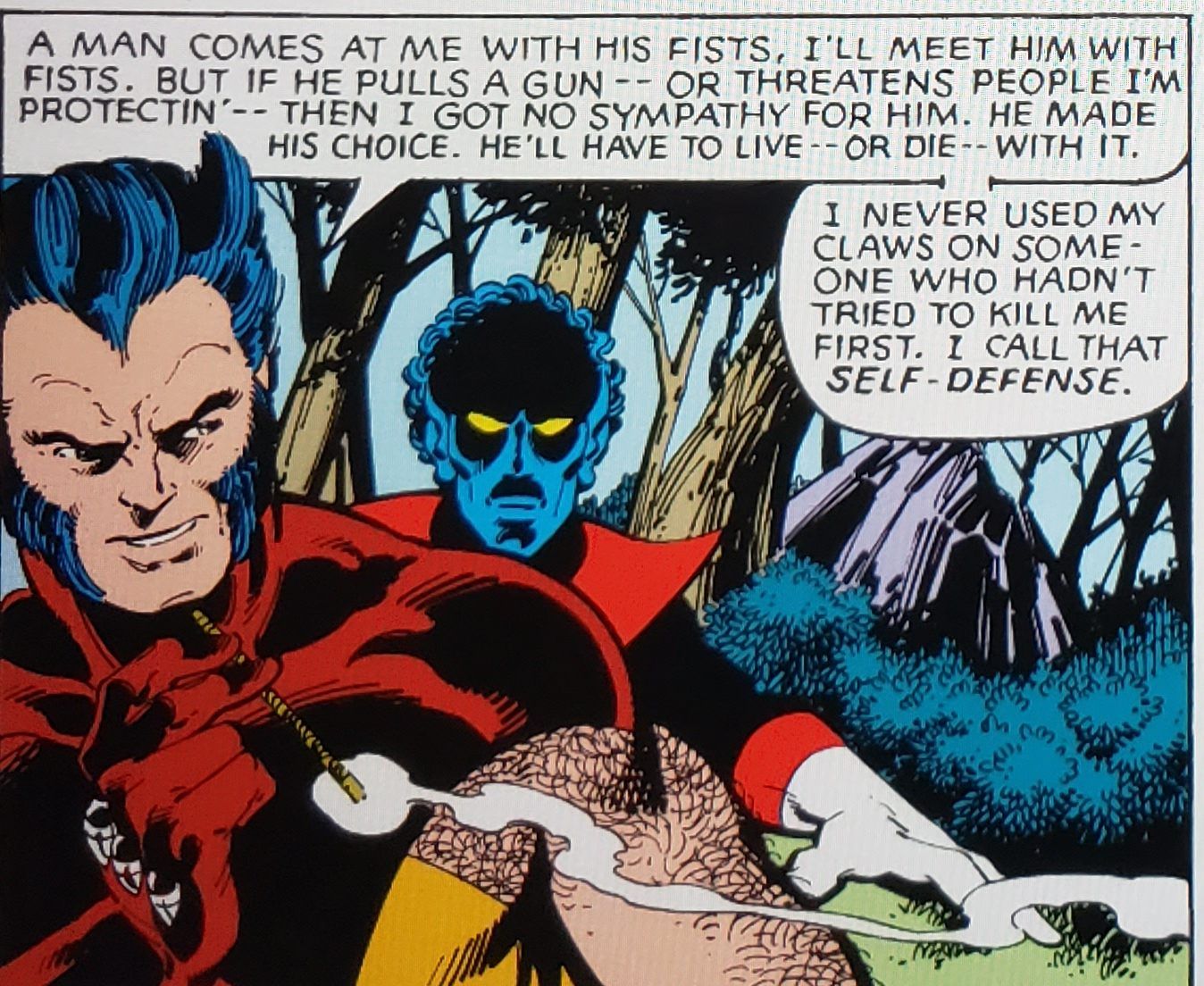
Though there have been times that Wolverine hasn“t always lived up to this, especially in stories not written by Claremont, this scene shows why Wolverine is different from many lethal anti-heroes. When written by Claremont, Logan is a character who doesn“t see himself as a murderer, and he doesn“t leap to killing as a first instinct in most cases. Logan is a soldier and a spy by trade, and he kills in the defense of the people he cares about. He doesn“t revel in murder, short of encounters with truly horrible villains like Sabretooth. Logan sees killing as a defensive act, one that is justified when presented with lethal force. He will respond to the lethal threat presented by his enemies, and he uses lethal force in defense of his friends and loved ones. Though Logan operates in the moral gray area, and he is still an anti-hero who kills when he deems it necessary, he isn“t quite as lethal as The Punisher either. It“s a distinction that often gets lost in the hands of other writers, but Claremont built a fascinating character study around it during his time with Logan.
Claremont and Byrne continue into their exploration of these moral gray zones in their last true landmark storyline, “Days of Future Past”“. It may be difficult for modern X-Men readers to fully appreciate how truly groundbreaking Days of Future Past was at the time, because it has inspired so many different spinoffs and similar stories since. This was the first X-Men storyline to deal with alternate futures and dystopian realities, which would impact later stories in Excalibur, Age of Apocalypse, Exiles, New X-Men, Age of X, and even the Jonathan Hickman era. It is difficult to imagine many of these stories existing in their current form if Claremont and Byrne hadn“t paved the fertile ground for them with Days of Future Past. It was the story that allowed X-Men writers to imagine the future of the X-Men, and the one it portrays is harrowing and even frightening.

According to Claremont, there were two primary inspirations for Days of Future Past. One was John Byrne“s idea of a story that imagined Kitty Pryde as the woman she would eventually become, since she was at that time the youngest member of the X-Men. The other was more driven by Claremont and his interest in the Sentinels: “What if the Sentinels win?”“ The two basic ideas connected well, using Kitty as the vantage point for the reader to see the dystopian world ruled by the Sentinels. She turns out to be a logical choice on several different levels, not least because Kitty is the reader identification character, the one X-Man that the audience can easily connect with. Kitty then becomes the natural character to show the future through, since she can bring the emotional connection to the story that few other X-Men can.
Admittedly, the original Days of Future Past will come across as obviously dated in some respects if you“re reading it for the first time today. The story makes the mistake of attaching specific dates, and this may throw modern readers. Claremont and Byrne are imagining the future of 2013 from the perspective of 1980, and even many years later, this would seem like a far-off time. Looking back on it from 2020 or later, this may throw modern readers out of the story and maybe even seem a little bit laughable. The technology and development of the 2013 of Days of Future Past will also come across as a bit antiquated by modern reckoning; even the Sentinels don“t seem quite that advanced, and modern conveniences that would be common in the real world“s 2013 are nowhere to be found. Still, much of this is explainable in hindsight, and enough of this story resonates that it“s easy to dismiss these kinds of concerns.
Chris Claremont was not a futurist or a technologist, but he understood enough to make a story about the future seem believable. In the first place, Claremont was a political science graduate, and he understood how political trends develop over time. He had a grasp of the sociological aspect of the future, and he developed a coherent explanation for why the Sentinels might eventually rule the world. The idea of a prominent US Senator“s assassination creating the popular will to hunt down and exterminate mutants sounds entirely plausible, especially given the danger that mutant powers could theoretically pose. One might even argue that Claremont was not terribly far off in his vision of the future, given the events of 2020 and how they echo the themes of this story. It helped that Claremont and Byrne told this story in 1980, where it hit the zeitgeist with perfect timing.
The second point in Claremont“s favor is that he was heavily influenced by classic science fiction writers, and it shows in his craft. Claremont occasionally referenced SF authors in his comics, and he especially took influence from authors like Robert Heinlein and Larry Niven. Though Claremont dealt with SF tropes many times before now, he was mainly working with pulp SF and space opera elements. Days of Future Past was written with more of a structural SF approach, using the language of science fiction to raise questions about the state of the world of his time. These kinds of SF stories usually focus on a single SF element””in this case, time travel””to explore the human consequences of technology. With Days of Future Past, Claremont and Byrne set up an imagined possible future, then leaves the reader with the question of what to do next.
In this timeline, mutants are on the verge of extinction, enslaved by the Sentinels in concentration camps or exterminated outright. The Sentinels have taken control of the American government, all in the name of their prime directive: the extermination of mutants. They have also eliminated all the super-heroes who might have resisted, with only a handful remaining either in camps or in hiding. The situation is desperate for the X-Men as well. Only Wolverine remains free, with only a few surviving X-Men alive in a Sentinel concentration camp. These survivors include Kate Pryde (an older Kitty), her husband Colossus, Storm, a reformed but disabled Magneto, an adult Frankiln Richards (the son of Mr. Fantastic and the Invisible Woman), and a telepath named Rachel Summers.
Rachel Summers is a character worth paying some attention to, since she eventually becomes a member of the present-day X-Men. Her full backstory is not developed until some years later when she travels back in time herself. Rachel is eventually established as the daughter of Scott Summers and Jean Grey, and she inherits her mother“s psychic powers. Of course, this raises the question of how this would be possible if Jean Grey is dead, and it is a point that Claremont addresses much later. It“s entirely possible that Rachel was planned around the time of Dark Phoenix, and it was simply an issue that was glossed over and left for readers to determine. For the purposes of this story, that backstory is never touched on. She“s simply Rachel, a telepath with the ability to send people back through time psychically, and the complicated backstory questions are simply brushed aside.
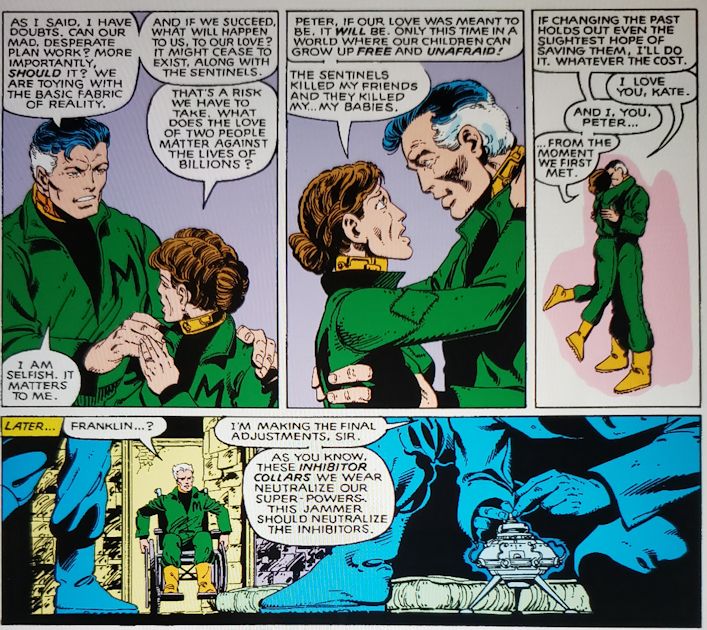
Kate Pryde proves to be a very different woman from the girl she was when she joined the X-Men. She“s much more capable, much more competent and experienced than the girl she is in the present. Kate has evolved in a different way than the way she“s shown in modern comics. She doesn“t seem to have ninja training, but she“s still a skilled fighter after learning from the X-Men. We also don“t see any of the more complicated power tricks that Kitty picked up in later years, though Kate likely acquired at least some of them. At the same time, Kate is a woman who has had her viewpoint soured by harsh experience. She found love with Peter Rasputin, but not the happiness she wanted. It“s carefully implied that the Sentinels murdered the children she had with Peter, and that this experience broke her. It“s this experience that likely prompts Kate to volunteer for the mindswap with her past self, in the hopes of saving her children in the new timeline. Kate is recognizable as Kitty in the right ways, but with a need to set the past right for her own reasons.
In the present, Kitty takes her first trip in the Danger Room, where she literally overcomes her first challenge with her eyes closed. This scene is important because it needs to establish a few things for the reader. Firstly, the story needs to show who young Kitty is, so that the mindswap with Kate becomes clear and dramatic. The reader needs to know who Kitty was, so that her transformation into Kate becomes evident. The reader also needs to see the difference between the two versions of Kitty, so that the audience can see the change in her. However, the Danger Room scene also gives the reader a brief moment of fun and laughter before the story turns back into darker territory and into the serious content that Claremont and Byrne are delving into.
Once the mindswap happens, Claremont and Byrne do an excellent job of making Kate seem like a 40-year-old woman driving the body of a teenager. Some of this is accomplished with her dialogue, which sounds much more mature and elevated than Kitty“s does. The rest can be credited to Byrne“s excellent visual storytelling and use of body language. The early scenes where Kitty is in control of her body come across as the movements of a teenager, while the Kate scenes show a more composed stance and the movements of a grown woman. Byrne was accomplished at posing his characters appropriately and setting the scene effectively, skills that help to distinguish the two Kittys without a word from Claremont to clarify the point.
Kate makes the point clear””unless something is done, the Brotherhood of Evil Mutants will assassinate Senator Robert Kelly, killing Charles Xavier and Moira MacTaggart along with him. The X-Men are understandably skeptical, and it“s only Wolverine“s intuition that Kate is telling the truth that sways Storm into agreeing. Still, the idea of taking Kate to Xavier is reasonable, if only to establish that Kate is telling the truth about the mindswap and the dark future in her memories.
In the future, the X-Men attempt to make their escape and reach the next stage of their plan, which is an assault on the Sentinel base at the Fantastic Four“s Baxter Building. Over the next two issues, each of the X-Men is killed until only Rachel and the mindswapped body of Kate Pryde are left. However, even though we know these aren“t the “real”“ X-Men of the main timeline, the deaths of these X-Men are still shocking and even touching, as if we“re losing the same people. In most modern time travel adventures, such deaths have been reduced to something trivial and even expected. Claremont, however, makes us care about these future X-Men in the short time we spend with them, and they feel like the same X-Men we know in the present. When each of them dies, hope that the future can be saved is gradually crushed, and it“s easy to grieve for the loss of these characters as they fall one by one. However, these are necessary deaths, because Claremont is pushing hope onto the present and the possibility of saving Robert Kelly from Mystique and her Brotherhood.
Claremont was always gifted at characterization, and he succeeds in even giving the villains some much -needed complexity. Mystique is not a villain that was created as an X-villain; he had created her for his run on Ms. Marvel, where she was an enemy of Carol Danvers. However, when she moved to the X-Men, she became a much more well-rounded villain, and she was an especially dangerous one during the 1980“s. At the same time, Mystique had humanizing elements even though she was a pro-mutant terrorist, especially in her relationship with her partner and lover Destiny. Mystique very quickly establishes her leadership over the Brotherhood by standing up to the Blob, reminding him that she is every bit as dangerous as Magneto in her own way. She is ruthless at the right times, but she cares about those she allows into her heart. We see that Destiny is the most important person to Mystique, but over time we see her emotional attachments to others as well. This is most obviously apparent with Nightcrawler because of their past, but also with Rogue, who would make her appearance later. Mystique grows into a complex villain over Claremont“s run, and it isn“t surprising that she“s become a fan-favorite character over the years.
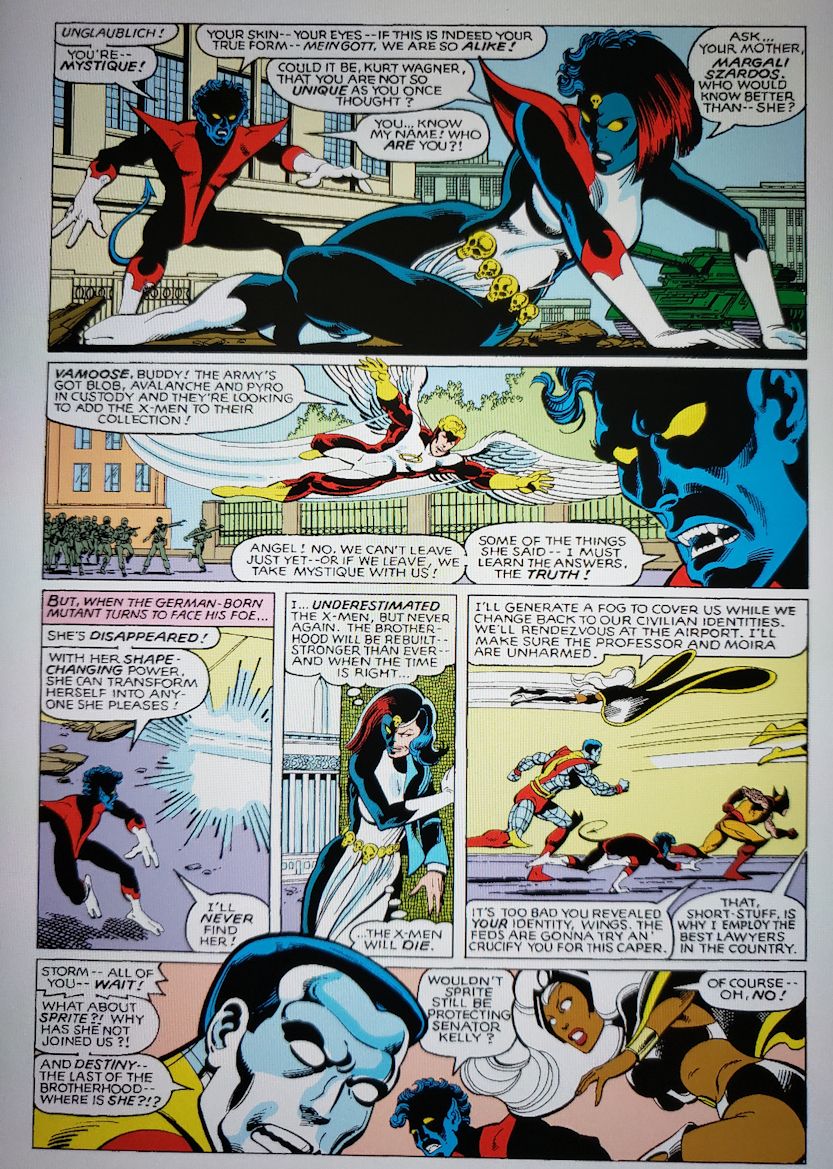
The second issue erupts into a long fight scene as the Brotherhood have their first battle with Storm“s X-Men. The action is very well executed, and there are some clever uses of mutant powers and team dynamics to score points on both sides. The most important battle among them is Mystique“s battle with Nightcrawler, where Kurt sees her true form for the first time, realizing that they look similar. Mystique“s only remark to Kurt on the question is for him to ask Margali Szardos, Kurt“s foster mother; she gives no answer beyond this. Still, the implication is very clear that Mystique is Kurt“s biological mother, a fact that wouldn“t be officially established until after Claremont left the X-Men titles. Or so it seems”¦ Claremont“s original intention was that Mystique was Kurt“s father (while shapeshifted into a man) and Destiny was his real mother. Unfortunately, it was an idea that was rejected by Marvel editorial at the time, and these gaps in Kurt and Mystique“s past would be left unfilled until later writers told those stories.
Most of the Brotherhood would be defeated during the battle, with Mystique as the sole member to escape. Destiny would be captured as well because of the influence of Kate Pryde, the one member whose future could not be read. Because of the mindswap with her future self, Kate becomes an element that the precognitive Destiny cannot foresee, allowing her to stop Destiny from murdering Robert Kelly. Once her task is complete, the mindswap reverts itself, and Kitty and Kate are restored to their proper time periods.
With this, Claremont makes the point that hope for the future to come lies in the actions taken in the present. The future cannot be read, but each good deed done today can influence the future in unexpected ways. Days of Future Past offers a warning of a bleak future, but it“s a story that offers hope while good people are there to change it. Claremont also uses Kitty to show that young people have the power to shape that future as well, because they can offer hope for a better society in the future. No matter how bleak the future may be, there is the potential for change.
Days of Future Past remains a classic X-Men story, and it“s perhaps the most successfully adapted one. X-Men: The Animated Series distilled the core of the story effectively, even with the change in characters, retaining the horror and the promise of the original“s themes. The film version of Days of Future Past changes considerably more, turning the story in ways that the original didn“t, but it likewise maintained the emotional core of the story. Days of Future Past is a much more elastic story than something like Dark Phoenix, since the core lies in the time travel and the idea of changing a bleak future for the better. It“s also one of the most influential X-Men stories of all time, impacting later comic book stories as well as adaptations.
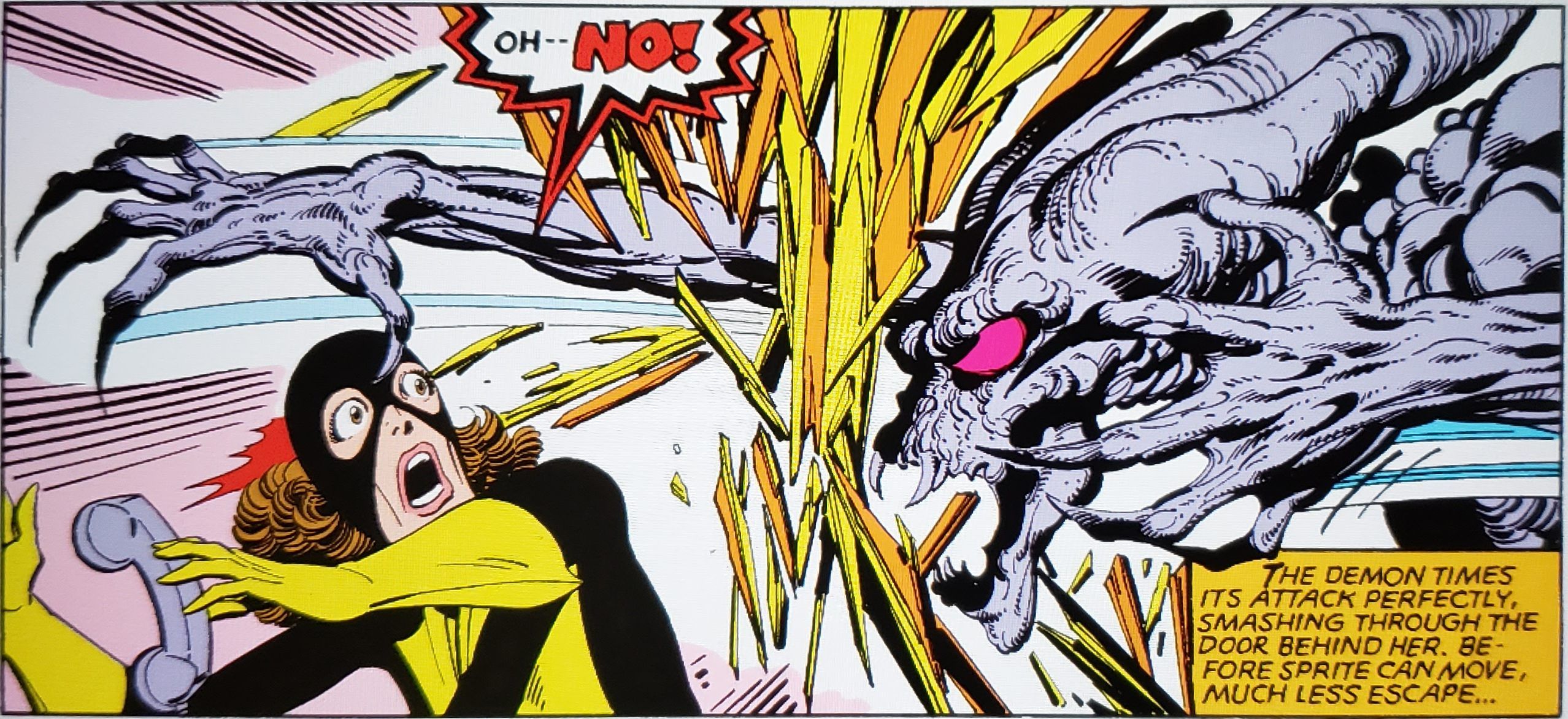
John Byrne“s last issue of Uncanny X-Men was a simple Christmas horror story centering on Kitty Pryde. This is an extremely logical position for Kitty, and one that sets up perhaps one of the best Kitty stories in the history of the character. In the first place, Kitty is the perfect kind of character who can play the “final girl”“ of a horror film. She“s clever, she“s innocent and pure of spirit, she“s tenacious, and her powers are defensive at best. She“s capable of being frightened by the monster, but she also has the strength to overcome her fear of the monster and the wits to defeat it. Kitty has the character qualities that make her well suited as a heroine for a horror story, in much the same way that Ripley does for Alien or Nancy does for Nightmare on Elm Street. Claremont and Byrne take full advantage of this, and it is an excellent final sendoff for Byrne as the series artist.
According to Lovecraft, one of the central points of the horror story is the fear of the unknown. This can work in one of two ways””the audience can know what the characters don“t, or both audience and characters are kept in the dark. Claremont and Byrne opt for the first method; they reveal the nature of the monster in the first act of the issue. The creature is revealed to be a surviving N“Garai demon from the first Claremont/Cockrum run who has come to the mansion looking for revenge on the X-Men. However, this is not information that Kitty ever knows, nor is it anything she could work with even if she did. At this point in her history, Kitty does not have the knowledge or the tools to fight a demonic enemy, and her powers prove to be a poor defense. All Kitty can do is run and hide in the mansion, using the various weapons she can improvise from what“s in the mansion. This builds up suspense, because the reader can see the danger Kitty is truly in while she“s stumbling in the dark.
Also, because the series has done such a good job of building tension and danger to the heroes, Kitty“s fate is truly in doubt. At this point, Chris Claremont killed off two X-Men, Thunderbird and Phoenix, and he likely thought to use this to ratchet up the tension. Kitty is in a real sense of danger from the N“Garai in nearly every panel of this issue, because it has the ability to kill her with ease. Her phasing power cannot protect her from the N“Garai, so her only hope is to run and hide from the creature. Even though she has plot armor on her side, the audience is not aware of this, because Claremont has shown that he“s willing to kill major characters to advance the story. It“s a bold move that he can get away with only because he laid that groundwork in previous issues. Kitty survives the encounter, but she“s on the losing end almost the entire time, and she only lives because she“s clever enough to use the mansion“s equipment against the monster.
I“ve mentioned in previous installments of this series that John Byrne is underrated at drawing horror, and this issue truly demonstrates this. Byrne“s design for the N“Garai is imposing and threatening, alien and almost Giger-esque in the presentation. Every panel is in motion, showing Kitty either running or taking some kind of action, showing the stakes of the action in every frame. Byrne gets across Kitty“s sense of fear, especially in her facial features; her eyes and mouth are very often agape in most frames where she“s trying to evade the N“Garai. The scene where the N“Garai pounds the door into splinters while trying to kill a frantic Kitty is a powerful scene, conveying her dread of the monster and the creature“s relentless drive to kill her. The last panel of the battle, with the N“Garai“s clawed hand reaching out to a frightened Kitty through the flames is a perfect comic book moment. It raises tension and the audience“s fear for Kitty, while leaving just enough doubt to make the reader wonder if the monster had killed her. It doesn“t, of course, and the ashes of the N“Garai“s hand in the final frame tells the entire story better than the script ever could.
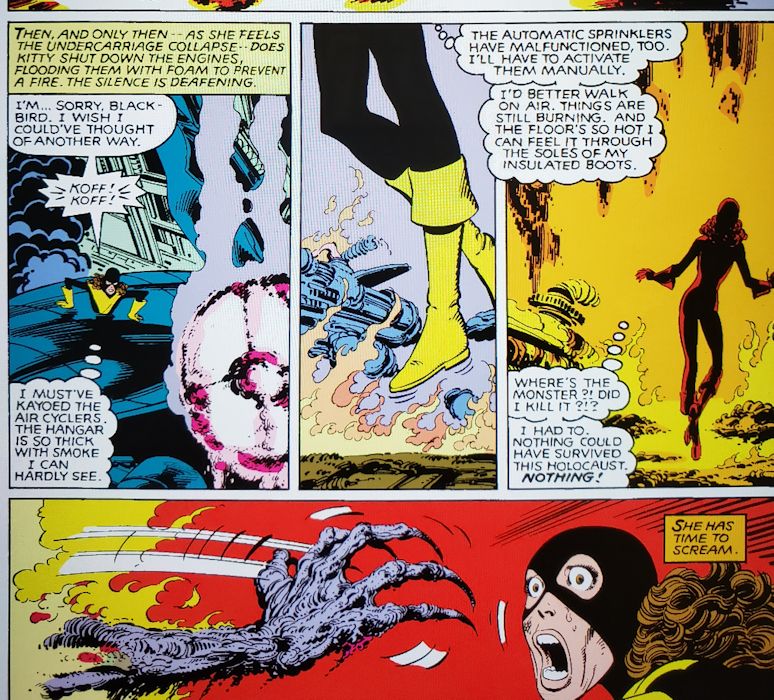
Though Byrne would take another hand at the X-Men universe, it wouldn“t be for many years. After leaving Uncanny X-Men, he moved on to Fantastic Four, where he was responsible for yet another historic run on major Marvel characters. As for the X-Men, Claremont pushed forward with his own storylines without Byrne“s involvement, reuniting once more with his old collaborator, the legendary Dave Cockrum. Next time, we“ll look into the return of Dave Cockrum, as well as the X-Men“s classic encounters with Magneto”¦ and the dreaded Doctor Doom!
Author Profile
- Steve Sellers had been a fan of superheroes ever since Superman: The Movie. But it took the JSA, the Legion of Super-Heroes, Dragonlance, Lord of the Rings, Twilight Zone, and Chris Claremont's legendary run on the X-Men to make him a writer and a longtime fan of comics, fantasy, and science fiction. Steve is the co-creator of WHITE DRUID & MICHAEL NERO and GUARDIANS OF ELAYIM for Omen Comics, and he is also the creator of BLITZ and SHOCKWAVE for Revelation Comics (an imprint of Omen Comics).





